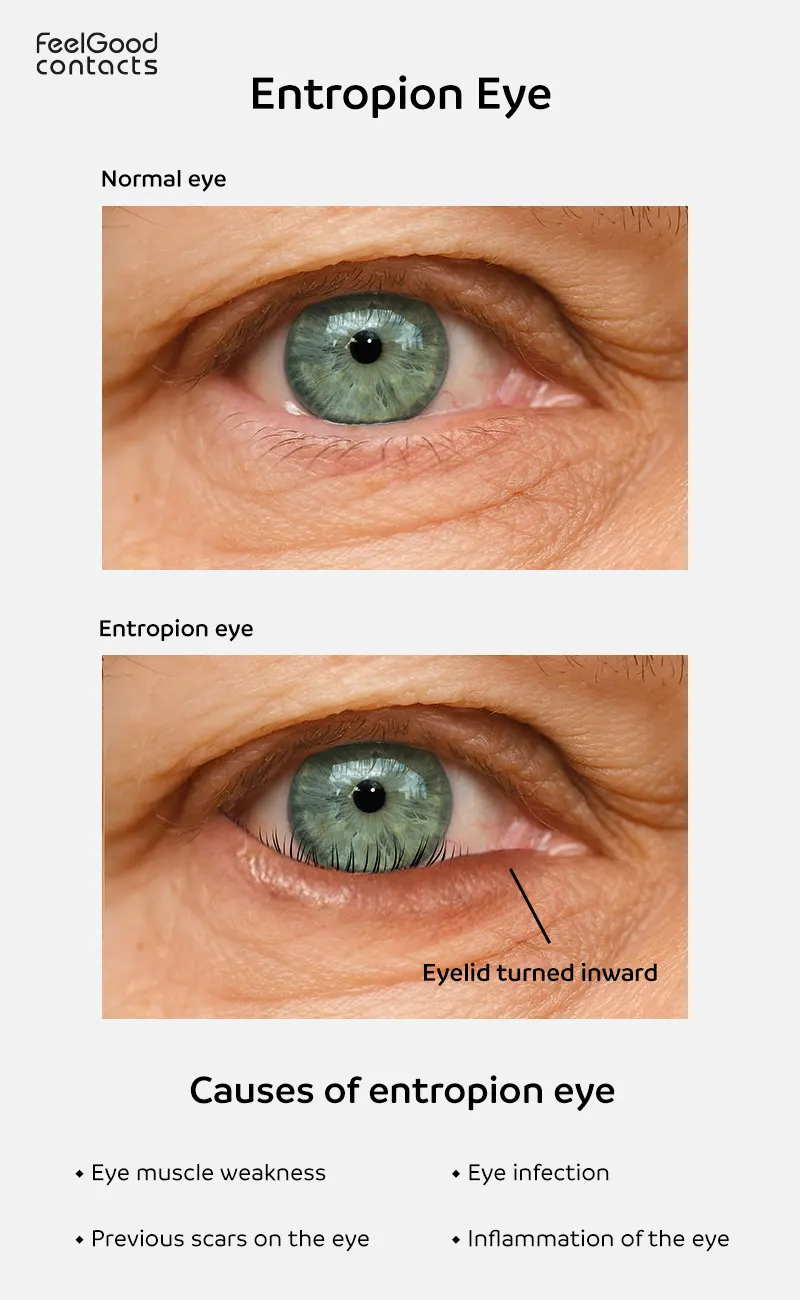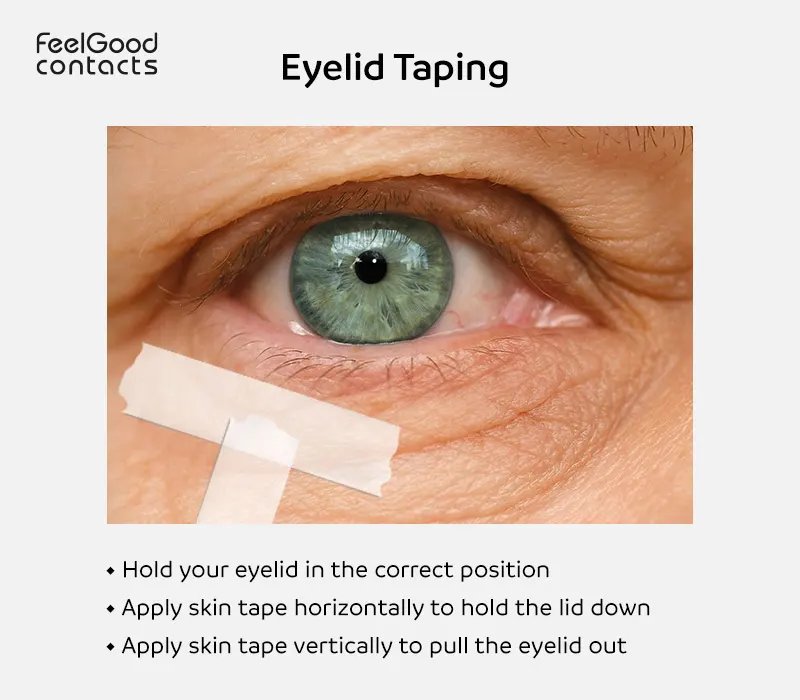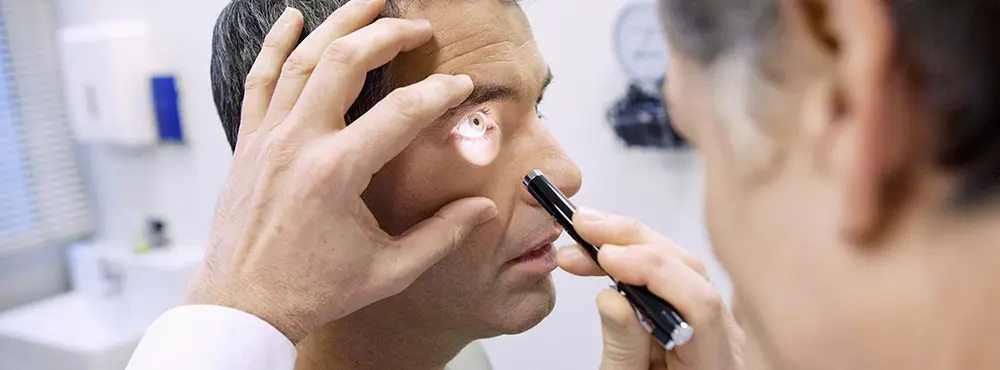What is an entropion eye?
Entropion eye is a condition when your eyelid turns inward towards your eyeball. It is usually not severe and is treatable. This condition causes your eyelid skin and eyelashes to rub against your cornea (the front part of your eyes), causing discomfort.
This condition usually occurs in the lower eyelid, and can affect one or both eyes. When both eyes are affected, it is called bilateral entropion. You may find your eyelids turned inside all the time or only the times when you blink hard. In rare cases, it can lead to vision loss too.
This condition is more common in older adults, usually over the age of 60. This eye condition can be treated using different measures, such as soft contact lenses, eye drops and surgery, depending on how severe your symptoms are.

What are the symptoms of entropion eye?
The symptoms can be mild at earlier stage, but with time they can become problematic or even worse leading to vision loss, if left untreated. Symptoms can vary:
Mild symptoms
- Mild redness of the eye
- Irritation in the eyes
- Itching
Moderate symptoms
- Red eyes
- Sore eyes
- Watery eyes
- A feeling of something stuck in the eye
Severe symptoms
- Pain in or around the eye
- Mucous discharge
- Blurred vision
- Sensitivity towards light or wind
- Red eyes – getting worse with time
If you’re experiencing any of the above severe symptoms, you must consult your optometrist immediately, as it can indicate potential damage to the cornea.
What causes entropion eye?
The most common cause of entropion eyelid(s) is the age factor; older adults, usually over 60 experience this condition. This is because the structural support to the eyelids loosens with age. However, there are more factors contributing towards entropion eyes, such as:
1. Muscle weakness
With age, the muscles and tendons under the eyes tend to weaken. As a result, the lower eyelid loosens, allowing the eyelids to roll inwards causing entropion or outwards causing entropion.
2. Scars or previous surgeries
If you have gone through surgeries due to previous trauma or accidents, this might be a factor that has affected the normal curve of your eyelid, making it loose.
3. Eye infection
Eye infection can lead to scarring of the lining of the eyes which can eventually cause entropion eye. Trachoma, the most common eye infection that causes entropion eye affects about 1.9 million people worldwide.
4. Inflammation
It is quite common for our eyes to feel dry or irritated. In such scenarios we get tempted to rub or squeeze our eyes. Doing so can affect the laxity of your eyelids which is a contributing factor to entropion.
5. Congenital
Although rare, this condition can be present at birth; this is when the infant has an extra fold of skin on the eyelid that causes eyelids to turn in.
How is entropion diagnosed?
This condition is usually diagnosed through a routine eye test. Your doctor will pull your eyelids to test the laxation. You might be asked to blink or close your eyes forcefully. This helps the doctor to assess your eyelid’s position, tightness and muscle tone of the eyelids. Your doctor will suggest different surgery/treatments based on how lax your eyelids are, hence, this test is important.
Any history of accident or surgery must be discussed with the doctor.
How do you fix an entropion on your eyelid?
There are different treatments available to treat this condition:
For mild symptoms, you can use lubricant eye drops to protect your eyes from getting irritated which eventually will help to fix the situation. But if you think your symptoms are getting worse, you must consult your ophthalmologist at your earliest convenience. Doctors might also recommend soft contact lenses, such as silicone hydrogel contact lenses to help prevent further damage.
Tackle moderate symptoms with eyedrops, or eye ointments. You can even use a combination of lubricant eye drops and eyelid tape,which is recommended by the NHS. Eyelid taping is a process of holding your eyelids using a skin tape, preventing them from folding inwards or outwards. This is taped from your lower lid to your cheek to pull your lid downwards, preventing your lashes from scratch your eyes. This is a temporary treatment, whilst the patient waits for their surgery.

If you’re experiencing severe symptoms, surgery would be recommended, which is a long-term solution. The surgery is a minor procedure and is usually carried out under local anaesthetic. It usually takes place on an outpatient basis, meaning you don’t have to stay in the hospital overnight.
There are different types of surgical procedures for entropion eyes, your doctor will recommend the most suitable options for you.
Types of surgeries:
Everting sutures
This process usually takes around 30 minutes. Three or four stitches are placed below the patient’s eyelashes to stop the eyelids from turning inwards. These stitches dissolves after eight weeks. The stitches create scars inside the lid, which hold the patient’s eyelid in place. Very rarely, the entropion can return, in such cases this surgery can be carried out again.
Please note that this process is not recommended for those whose eyelids are very weak/lax.
Eyelid tightening with everting sutures
Eyelid tightening is a good option for those whose eyelids are weak/lax. It is a 45–60 minute procedure. You will be treated under local anaesthetic. To tighten the eyelid, a small part of your eyelid is removed. This part can be removed either from inside or outside of the eyelid, depending on which part is most lax. The gap will be closed with stitches, then two or three stitches are placed below the eyelashes to hold the tighten the eyelid, preventing it from turning inwards.
In very rare cases, when surgery is not possible, patients are recommended to go for Botox injection. In this process, the injection is applied on your lower eyelid to help relax the muscles and prevent it from turning inwards or outwards.
Please note that Botox is a temporary measure and usually lasts no more than two to three months.
Wut Win, the Dispensing Optician at Feel Good Contacts mentioned,” As we can’t prevent this condition, it’s best to use eye drops regularly as soon as you notice some symptoms and it’s important to have regular eye tests with an optician”.
Disclaimer: The advice in this article is for informational purposes only and does not replace medical care or an in-person check-up. Please check with an eyecare professional before purchasing any products or remedies. For information on our article review process, please refer to our Editorial Policy.

 Offers
Offers Account
Account
 Favorite
Favorite
 Basket
Basket

 OFFERS
OFFERS


















